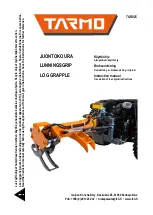
IV.
OPERATING SYSTEMS
C. HYDRAULIC SYSTEM
DETASSELING SYSTEM
50
DETASSELING HEADS (QUAD PULLERS/ CUTTER HEAD)-
The detasseling heads (fig. 50-3, 50-4) each have a hydraulic motor that
is responsible for the rotation of the wheels or blade. Careful attention
must be paid to the flow direction when replacing hoses! Failure to prop-
erly attach hoses may result in personal injury or machine damage.
Each set of motors is individually turned on with a switch located on
the combo control panel (fig. 50-5). The switches correspond with the lift
sections (not the detasseling heads) from left to right when sitting in the operator’s seat. If there are only four
lifts, the first and last switch will not control anything.
Depress the top of the switch to activate the set of detasseling heads and the bottom of the switch to turn
them off.
The motors are hydraulically driven in direct relation to engine RPM. This means that in order to have the
optimal pressure for the motors
the engine RPM must be main-
tained at 2500 RPM during op-
eration. Continue reading the
Operating Systems section for
more information.
FIG. 50-3
FIG. 50-4
FIG. 50-5
MOTOR CONTROL VALVE–
The motor control
valve is an adjustable needle valve that controls the flow of
hydraulic oil to the hydraulic motors of the detasseling
heads.
The solenoids are opened using the switches on the
combo control panel (fig. 50.2). Depress the top of the
switch to turn them on, and the bottom of the switch to turn
them off.
The work mode switch on the side console and the main control switch on
the hydrostatic lever must be activated for the hydraulic motors to work.
FIG. 50-1
FIG. 50-2
OPERATING SYSTEMS












































